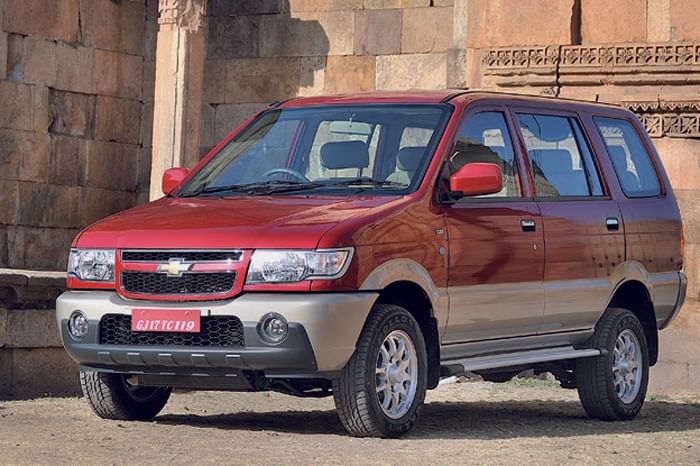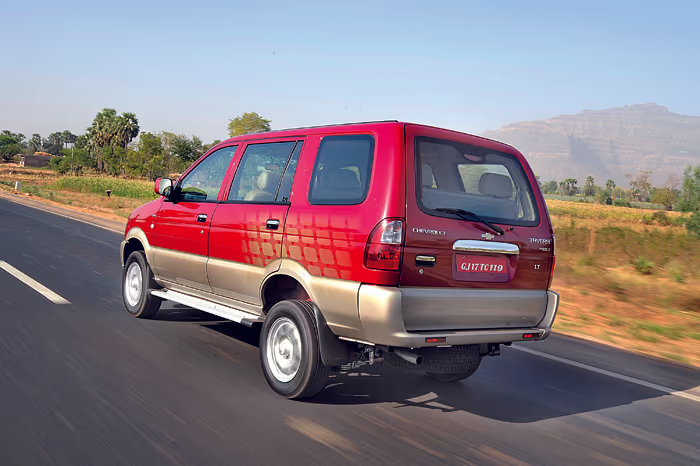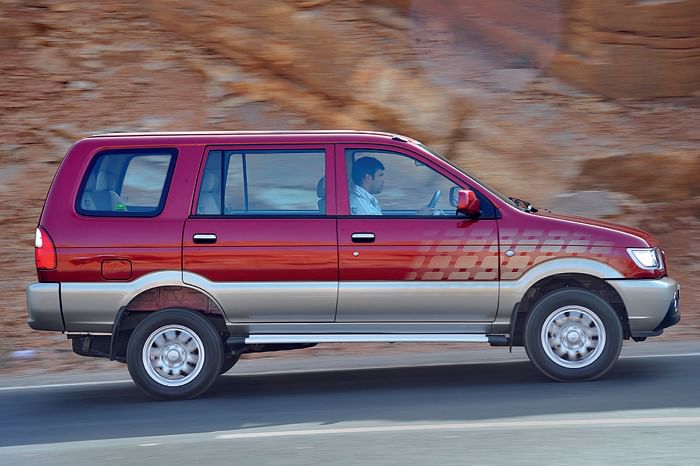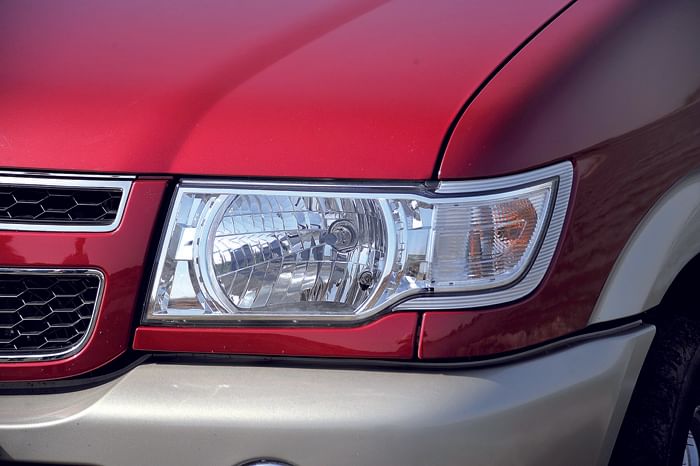Chevrolet Tavera Neo 3 review, test drive
The Tavera gets a new engine and a whole host of improvements. We sneak in a quick drive.
Published on Apr 10, 2012 10:12:00 AM
1,92,127 Views
Follow us on



What you’re looking at is the Tavera Neo 3. While it may look rather similar to the Tavera you saw on the street yesterday, this one features the single biggest improvement since the original of 2004. It’s a change that’s been brought about because of emissions regulations. The Isuzu 2.5-litre turbo-diesel under the hood of the old Tavera couldn’t be upgraded to meet BS IV emissions norms, forcing GM to pull the plug on it in the big metros.
GM India had been scouting around for a fresh powertrain that could not only meet the latest emissions regulations, but which was also low on cost and cheap to maintain. This didn’t leave many options, and the company eventually found a rather obscure solution – the 2.0-litre common-rail diesel that powers the ambiguous ICML-Sonalika Rhino. However, the pedigree of the engine isn’t that bad. It’s a Rover engine that ICML manufactures at its plant in Hoshiapur in Uttar Pradesh.
It’s a relatively uncomplicated motor – it uses a two-valve per cylinder, single overhead camshaft layout, but also has piezo injectors that support upto four injections per cycle and inject fuel at a pressure of upto 1600bar. Though the Tavera and Rhino have similar body styles and are used for the same applications, wiggling the new engine into the Chevy’s engine bay was no easy task. This engine was originally intended for a transverse layout in a Rover, and GM had a considerable challenge tweaking the noise, vibration and harshness package to suit its longitudinal application in the Tavera. New engine mounts had to be designed; the cooling package had to be improved and all this had to be done within the existing constraints of the Tavera’s engine bay. Other challenges came from the fact that the previous BS III motor had its air intake on the right of the engine, and the common-rail one has its on the left. This made the accommodation of the turbocharger and exhaust manifold even more complicated.
Though the Rhino and the Tavera share the same engine, there is one big difference and that’s in the form of the ECU. GM’s engineers have tweaked the maps to suit what they think is the best compromise between emissions, driveability and refinement. This is also probably why the Tavera’s engine makes 14bhp less than the Rhino’s claimed power output.
The Tavera also uses a different five-speed manual gearbox, which has been lifted from GM’s North American parts bin – the engineers didn’t say where exactly it comes from. They did share an interesting detail though – because the Tavera comes with a ten-seat option, GM had to design two linkages to suit different gearlever locations – one that sits further ahead on the floor console (front bench seat versions) and one that’s easier to reach (bucket seat versions).
The gearlever in this top-of-the-line LT, with its front bucket seats, is too far back and would hit the middle passenger’s tender bits on the bench seat versions – you can imagine a yelp everytime you snatch second gear!
Another challenge for GM was the modification of the propeller shaft, which had to be shortened considerably because of the difference in wheelbase between the Tavera and the Rhino.
Power up
What you notice immediately is the new engine’s refinement. There’s a slight shudder when you start it, but it settles soon enough into a smooth and quiet enough idle. Off the line, you need to slip the clutch a bit initially, but then the torque kicks in and the engine picks up cleanly and power delivery is quite linear. The spec sheets reveal that peak torque of 26.8kgm kicks in at a rather high (for a common-rail diesel) 2500rpm, but there’s enough torque below this to make the Tavera satisfyingly responsive to drive. In fact, part-throttle responses are the engine’s forte – it responds almost instantly to a gentle flex of your right foot. First and second gears feel peppy, but there’s a curious flat spot between 2000 and 3000rpm in third. It’s something that doesn’t show up in fourth and fifth though, the Tavera cruising happily at 120kph. This is actually the biggest difference between the new and old motors. The Isuzu motor, with its light turbo, was very drivable and responsive, but it ran out of breath at around 100kph and didn’t feel as relaxed on the highway.
Our VBOX tells us exactly how much the difference between the old and new is. The common-rail Tavera gets to 100kph in 17sec, an astonishing 8sec faster than the old car, and it’s much more responsive too. Other drivetrain plusses include the light and positive gearshift and the overall refinement levels that make the new Tavera quieter than before.
Bump up
Because the common-rail engine weighs almost the same as the BS III unit, GM hasn’t had to play around with the front suspension settings much. The rear, however, gets a few changes – the ride height has increased, and the rear suspension gets thicker leaf springs. The Tavera now gets gas-charged dampers at all four corners as well.
What this does to the handling is rather predictable – there’s lots of body roll and it runs out of grip quite easily when pushed hard into a corner. It simply doesn’t like being driven hard, which is fine – its application doesn’t require it to be a nimble corner carver. It does feel stable in a straight line, though, and the added ride height and thicker springs will no doubt help it carry more people.
It rides decently too and the suspension is quite refined in the way it absorbs bumps. However, the roads around Halol were in excellent shape, so we’ll reserve our judgment till we bring it down fora ‘real-world’ test in Maharashtra.
Moving up
GM knows the taxi market is a Tavera stronghold, but is still keen to push this BS IV version as a personal-use car. Which is exactly why the interiors on this top-end LT variant are two-tone grey and beige, there is an in-built audio system, power windows all round, a dead pedal, twin gloveboxes and leather seats. However, quality wise, it still falls far short of what customers now expect, and the overall ambience is still a bit too rudimentary. There are some improved bits like the new dials and the mock carbon-fibre finish on the centre console and gearlever, but then you also get ill-fitting panels like the instrument console surround. GM says it is ironing out these final quality issues.
There’s a huge improvement in the quality of the switchgear though – the old Tavera’s flimsy, Maruti 800-sourced stalks ditched for sturdier, more tactile units. However, the overall quality of dashboard plastics – there are lots of hard surfaces – doesn’t feel as plush as the Mahindra Xylo’s. Also revealing the Tavera’s age are the slim doorpads, tiny door pockets and the odd power window switches.
The seats are reasonably comfortable, if a bit unsupportive when compared to the Xylo’s, but the low window-line and big glass area gives you a great view out – something that’s always been a Tavera strength. This seven-seat version has captain chairs in the middle row. The individual seats slide back and forth, allowing you to adjust legroom for both middle- and third-row passengers.
What’s impressive is the Tavera’s air-conditioning and though it’s not peak summer yet, the afternoon of the drive was hot enough to give us some idea. The Tavera’s cabin remained chilled at all times because, according to GM’s engineers, the air-con compressor never shuts off, not even when the engine is under full load. We wonder what impact that would have on fuel efficiency though.
Face up
The facelift is just mildly cosmetic and includes a new grille, headlights and front bumper, whilst some stickers point it out as the Neo 3. There are smart new alloys as well. As you’d expect from a facelift, there are no expensive sheet-metal changes, so the Tavera is instantly recognisable as a Tavera. However, the rear does look excessively raised and when you’re following the car; you can now see its undersides quite clearly.
Verdict
The Tavera has been improved substantially from its previous version and this is mostly down to the stronger, cleaner and quieter engine. This, along with the stronger suspension and the general improvements throughout the car, has made the Tavera a better people-carrier. Still, as a personal-use car, it falls short and this is mainly because its interiors aren’t as appealing as those of its competition and it has a rudimentary feel to it. Also, it does look quite old now.
Of course, a lot depends on the price which we estimate to be Rs 9-10 lakh. However, if GM keeps the price honest, you’re looking at a hardy, much improved and very able people-mover.
Tech Specs 
Copyright (c) Autocar India. All rights reserved.

 Engine
Engine Transmission
Transmission Efficiency
Efficiency Body
Body Suspension
Suspension Brakes
Brakes Dimensions
Dimensions
Comments
Member Login
Personal Details
No comments yet. Be the first to comment.